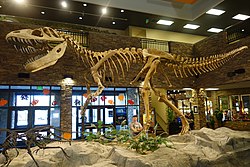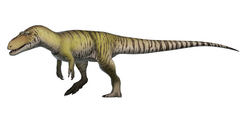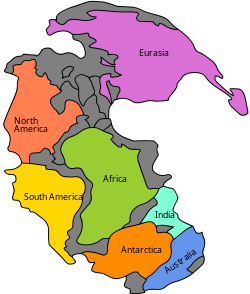| Megalosaurids | |
|---|---|
 | |
| Skeletal mount of Torvosaurus tanneri, Museum of Ancient Life | |
| Scientific classification | |
| Kingdom: | Animalia |
| Phylum: | Chordata |
| Class: | Reptilia |
| Clade: | Dinosauria |
| Clade: | Saurischia |
| Clade: | Theropoda |
| Clade: | † Megalosauria |
| Family: | † Megalosauridae Huxley, 1869 |
| Type species | |
| † Megalosaurus bucklandii Mantell, 1827 | |
| Subgroups | |
| |
| Synonyms | |
| |
Megalosauridae is a monophyletic family of carnivorous theropod dinosaurs within the group Megalosauroidea. Appearing in the Middle Jurassic, megalosaurids were among the first major radiation of large theropod dinosaurs. [1] They were a relatively primitive group of basal tetanurans containing two main subfamilies, Megalosaurinae and Afrovenatorinae, along with the basal genus Eustreptospondylus , an unresolved taxon which differs from both subfamilies. [2]
Contents
- Description
- Body size
- Anatomical characteristics
- Dental morphology
- Classification
- Historical classification
- Phylogeny
- Palaeoecology
- Palaeogeography
- References
The defining megalosaurid, Megalosaurus bucklandii, was first named and described in 1824 by William Buckland after multiple finds in Stonesfield, Oxfordshire, UK. Megalosaurus was the first formally described dinosaur and was the basis for the establishment of the clade Dinosauria. It is also one of the largest known Middle Jurassic carnivorous dinosaurs, with the best-preserved femur at 805 mm and a proposed body mass of around 943 kg. [3] Megalosauridae has mainly been recognized as a European group of dinosaurs, based on fossils found in France and the UK, but fossils show that the group is also found in North America, Africa, South America and possibly Asia. [4] [5] [6]
The family Megalosauridae was first defined by Thomas Huxley in 1869, yet it has been contested throughout history due to its role as a "waste-basket" for many partially described dinosaurs or unidentified remains. [7] In the early years of paleontology, most large theropods were grouped together and up to 48 species were included in the clade Megalosauria, the basal clade of Megalosauridae. Over time, most of these taxa were placed in other clades and the parameters of Megalosauridae were narrowed significantly. However, some controversy remains over whether Megalosauridae should be considered its own distinct group, and dinosaurs in this family remain some of the most problematic taxa in all Dinosauria. [5] [7] Some paleontologists, such as Paul Sereno in 2005, have disregarded the group due to its shaky foundation and lack of clarified phylogeny. However, recent research by Carrano, Benson, and Sampson has systematically analyzed all basal tetanurans and determined that Megalosauridae should exist as its own family. They have been generally closely related to the family Spinosauridae.


























